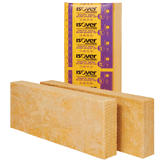- Blogs
- A Comprehensive Comparison of Knauf Dritherm 32 and Dritherm 37 Insulation
A Comprehensive Comparison of Knauf Dritherm 32 and Dritherm 37 Insulation

Knauf's Dritherm insulation product line offers two distinct variants, Dritherm 32 and Dritherm 37, each designed to cater to specific thermal insulation needs. This article aims to provide a comprehensive comparison between these two variants, delving into their thermal performance, intended use, available thicknesses, pricing, and overall cost-effectiveness.
Thermal Performance Distinction:
The primary distinction between Knauf Dritherm 32 and Dritherm 37 lies in their thermal conductivity, which directly influences their insulating properties. Dritherm 32 boasts a lower thermal conductivity (0.032 W/mK) compared to Dritherm 37 (0.037 W/mK), resulting in superior insulation capabilities. This difference in thermal conductivity is crucial, as it determines the amount of heat energy conducted through the material per unit thickness and temperature gradient.
Insulation Efficiency and Effectiveness:
Dritherm 32 excels in insulation efficiency due to its lower thermal conductivity. This attribute leads to a reduced transfer of heat energy through the material, resulting in greater energy savings and enhanced comfort within the building. The insulation performance comparison reveals that for the same thickness of material, Dritherm 32 offers better insulation than Dritherm 37. This efficiency translates into reduced energy consumption for both heating and cooling, contributing to a more sustainable and cost-effective solution.
Intended Applications:
Both Dritherm 32 and Dritherm 37 are tailored to specific applications based on their thermal performance characteristics. Dritherm 32, often referred to as 'Dritherm 32 Ultimate', finds its niche in residential building cavity walls that demand elevated thermal performance. On the other hand, Dritherm 37 serves as a standard-grade insulation for cavity walls. The primary divergence is rooted in their thermal conductivities, where Dritherm 32's enhanced insulating properties make it the choice for higher thermal performance requirements.
Available Thicknesses:
The availability of different thickness options for each grade is a key consideration. Potential buyers are advised to consult the manufacturer's specifications or datasheets to determine the suitable thicknesses for their projects. Varying thickness options enable tailoring insulation choices to the specific needs of a building, ensuring optimal thermal performance.
Cost Considerations:
An important facet of selecting insulation is the cost-effectiveness analysis. While Dritherm 32 may carry a higher initial price tag than Dritherm 37 due to its improved thermal performance, the long-term benefits of energy savings often justify the initial investment. The enhanced insulation capabilities of Dritherm 32 result in reduced energy consumption, leading to lower utility bills over time. Therefore, the decision between the two variants should factor in the potential return on investment stemming from Dritherm 32's better insulation and energy efficiency.
Tabular Difference between Knauf Dritherm 32 and Dritherm 37 Insulation
| Aspect | Dritherm 37 | Dritherm 32 |
| Thermal Efficiency | High | Enhanced |
| Application Versatility | Wide range of applications | Ideal for demanding standards |
| Thickness Options | Various available thicknesses | Various available thicknesses |
| U-Value Performance | Excellent | Exceptional |
| Material Composition | Advanced insulating materials | Enhanced insulating materials |
| Sustainable Practices | Environmentally conscious manufacturing | Eco-friendly manufacturing processes |
| Thermal Conductivity | Meets industry standards | Improved thermal conductivity |
| Higher: 0.037 W/mK | Lower: 0.032 W/mK | |
| Heat Capacity | Good | Enhanced heat capacity |
| Resistance to Temperature | Effective against temperature changes | Improved resistance to temperature |
| Long-term Cost-effectiveness | Offers energy savings over time | Potential for significant savings |
| Installation Requirements | Industry-standard installation | Industry-standard installation |
| Environmental Impact | Committed to sustainability | Aligns with green construction values |
| Customer Feedback | Positive feedback from various projects | Positive feedback for enhanced performance |
| Recommended Applications | Diverse construction projects | Projects with demanding regulations |
| Thermal Performance | Standard-grade insulation | Better insulation due to lower λ value |
| Intended Use | Standard-grade insulation for walls | Cavity walls with high thermal needs |
| Price | Typically lower cost | May be priced higher due to performance |
| Thickness Availability | Varies; consult manufacturer's specs | Varies; consult manufacturer's specs |
| Energy Savings | Less efficient in terms of insulation | Better energy savings and efficiency |
| R-Value | Lower due to higher thermal conductivity, Less Energy Savings | Higher due to lower thermal conductivity, High Energy Savings |
| Long-term Benefits | Moderate energy savings | Potential for significant energy savings |
Similarities between Dritherm 32 and Dritherm 37 Insulation

| Aspect | Dritherm 32 | Dritherm 37 |
| Manufacturer | Knauf | Knauf |
| Product Range | Dritherm | Dritherm |
| Application | Cavity wall insulation | Cavity wall insulation |
| Material | Fibre Glass | Fibre Glass |
| Climate Suitability | Varies based on specs | Varies based on specs |
Frequently Asked Questions
Q: What Is the Difference in Thermal Conductivity Between Knauf Dritherm 32 and Dritherm 37?
The thermal conductivity difference between Knauf Dritherm 32 and Dritherm 37 is the primary factor that distinguishes these two insulatio

Samuel Hitch
Managing Director
Buy Insulation Online.
Leave A Reply
Your feedback is greatly appreciated, please comment on our content below. Your email address will not be published. Required fields are marked *











































































































































































































































































































































































